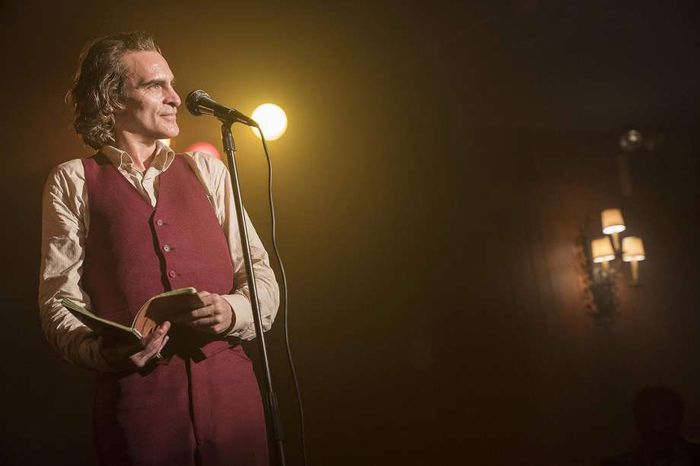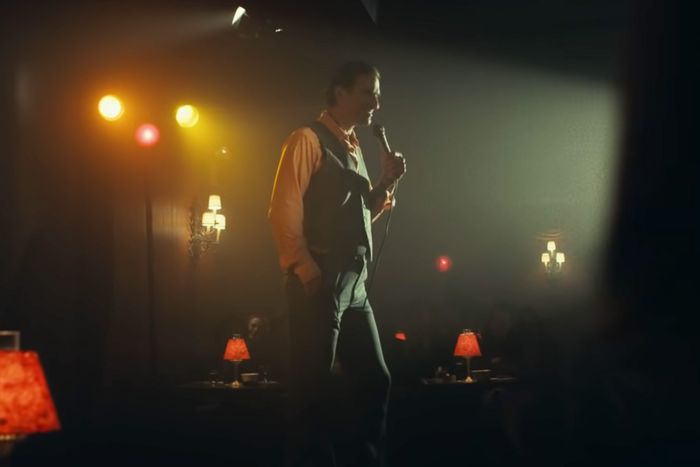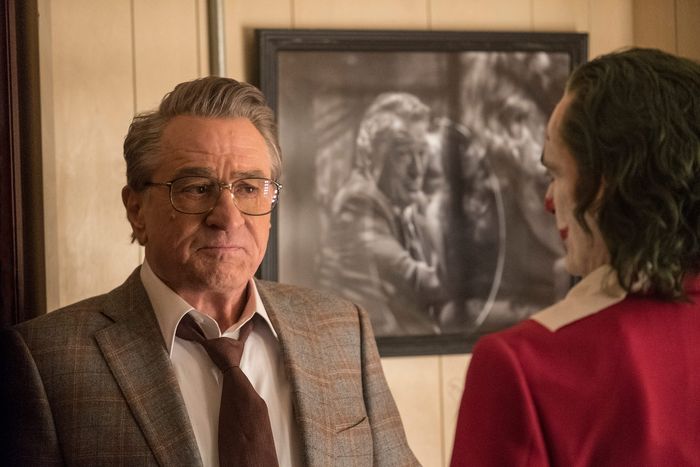
Joker is many things to many people — a misguided commentary on mental illness and sociopolitical rage, a glorification of incels, an antidote to “woke” culture, etc. etc. — but everyone can agree that, feelings aside, it tells the story of an aspiring stand-up comedian. And even though it’s not a funny movie, unless your sense of humor is beyond warped, it employs several bona fide comics: Marc Maron, Saturday Night Live’s Chris Redd, Late Night With Seth Meyers writer Ben Warheit (as one of the subway victims), and stand-ups Gary Gulman and Sam Morril playing themselves, performing snippets of their real-life acts at Gotham City club Pogo’s, where Arthur Fleck disastrously goes onstage at an open mic.
Given that director Todd Phillips strove to tell Joker’s origin story with gritty realism, it made sense that he chose real-life stand-ups for Arthur to emulate. Morril landed his role by getting a call from Phillips himself, while Gulman was suggested by a casting staffer. “It was out of the blue. I’m assuming that they couldn’t go with somebody too famous, because it would take you out of the scene,” Gulman tells Vulture. “I had no lines, but Todd and I went over what I wanted to do for jokes, and he said it needed to be something that wouldn’t flag what time period they were in.”
They ultimately went with Gulman’s bit about role-playing with his wife, while Morril did different segments from his act, with one about sex and cars making the final cut. “I was like, ‘If I’m at an open mic, do you want me to bomb?’” Morril recalls asking Phillips. “And he said, ‘No, do whatever.’ I said, ‘Good,’ because I don’t want to bomb with my own jokes. That’d be pretty weird: ‘Here’s my jokes not hitting in the biggest movie in the country.’” (Both comics also declined to tell friends they were in the movie, thinking their scenes might be cut.)
To give it the early-’80s feel, Phillips chose Dangerfield’s, Rodney Dangerfield’s longtime New York City club, as the filming location. “It’s a dated club, so they probably didn’t have to do that much to make it work,” says Gulman. “There were matchbooks that said Pogo’s on it, and the people in the audience were dressed in period outfits with their hair done, smoking cigarettes.” Though the extras for Morril’s set were welcoming — “I think they were expecting me to suck,” he says — Gulman had a harder time with the crowd at first.
“The first five or six takes, I was irritated because there was an extra laughing too loud. I was thinking, Are they trying to get a bigger part? They’re ruining my timing. Then I realized it was the Joker,” he recalls. “I didn’t think Joaquin Phoenix would be in my shot. I figured they’d have his stand-in. Once I calmed down from feeling like an idiot for not realizing who it was, it was really smooth.”
The scene may seem fairly insignificant, with Phoenix enjoying Gulman’s set and jotting down notes about eye contact and making jokes about sex, but the details are actually pivotal to Arthur’s attempts at comedy. “They made me a time-period suit. Phillips said, ‘Arthur would be learning from you and taking notes and he would try to dress like you.’ He even slicked his hair back like me,” Gulman recalls, noting that the point of his role-playing bit, in which he pretends to be a very strict professor, is that it’s not sexy at all. “He’s completely misinterpreting it. The other thing was that it was sad, because it was all couples at the show and he was by himself.”
It’s these mistakes that ultimately lead to Arthur’s embarrassing open-mic set, where he involuntarily cracks up and hallucinates both his success and the presence of his love interest. Morril got to watch Phoenix filming that scene and was blown away by how realistic it was. “It’s almost like you have PTSD from all the open mics you have to do to get good at this,” he says. “To their credit, that’s what an open mic is. You’re supposed to experiment and take risks, and that’s where you’re supposed to fail. But that’s why I really hated mics — I didn’t mind bombing, it was the sitting through all the bad comedy that made me really just hate life.”
By “bad comedy,” Morril means the kind of set like Arthur’s, where the comedian isn’t just not funny, they’re obviously not fully tethered to reality. What makes his take on Phoenix’s performance even more interesting is that, during filming, he didn’t know any of the context about the plot and, when he spoke with Vulture, he had yet to see the movie.
“There’s people who do comedy and don’t have any self-awareness. He’s a loner, right? Usually, when you have friends, they give you hints of what’s funny about you. That felt like a character who didn’t have friends guide him and tell him what was good. It felt like a very lost person. He tells that old, bad street joke, ‘I told them I want to be a comedian and everyone laughed at me, but no one’s laughing now!’ When you open with a joke that’s not yours, to me that shows fear that you’re not a good comic. He did that a few different ways, and each way made me uncomfortable. It was pretty hard to watch.”
According to an interview with Phillips, Phoenix was often so intense on the set that he’d walk off in the middle of takes to gather his thoughts. Neither Gulman or Morril saw anything as over the top as that, but both had interesting interactions with the star. “When I saw him in the makeup trailer, it seemed like he was like in character because he didn’t really make eye contact,” says Gulman. “He was friendly in that he smiled and nodded his head, but also maybe he just doesn’t feel comfortable around strangers. It’s hard to say, but he is really handsome.”
Morril’s was much different. “He chatted with me for a while and he was not what I expected,” Morril says. “I was scared to talk to him because I didn’t know if he’s the type of actor that stays in character in between takes. He said, ‘I really like your act because it’s just funny. Sometimes stand-up can feel desperate, and I don’t get that feeling from you at all.’ Maybe he was being nice to me as the Joker.”
Both also have visceral reactions to the plot point where Arthur’s set is filmed and goes viral, thanks to late-show host Murray Franklin, played by Robert De Niro. “[An open mic] is supposed to be a place where you risk absolute vulnerability,” says Morril. “Filming at a comedy club is terrible for a professional, but to do it to someone at their absolute worst is pretty cruel. But you know how that goes — it’s in people’s nature to be happy to see you in pain. It’s such an ugly quality.”
“The way that scene plays out, it’s just so uncomfortable. I could relate to that because probably early on in my career, you’re so desperate you would allow yourself to lose your dignity to get that. It was his dream,” Gulman says of Joker’s fateful appearance on Franklin’s show. “He was right about telling that guy off for embarrassing him. It was really cruel. At first, I thought, He got this break to go on the show, and if he had just not murdered anybody, maybe it could’ve helped him out — that it’s just that his timing was off. I felt so bad for him, and then, like all supervillains, he took it too far. You should never, never murder the host during the show for America to see. It’s just bad form.”
Gulman, who shares his struggles with depression and anxiety in his new HBO special The Great Depresh, is ultimately sympathetic to Arthur/Joker, relating to the experience of needing mental health treatment but not being able to access it. The connection was formed well before the movie, when Gulman read the 1988 graphic novel Batman: The Killing Joke, which first gave Joker the backstory of being a failed comedian and partly inspired Phillips’s movie. “I was struggling with comedy when I read that because I was so new and it was so frustrating,” Gulman says. “I remember thinking, Only a failed comedian could have the frustration to go out there and become a supervillain, because it’s so humbling and you want to be good so bad. That origin story made more sense to me than falling in a vat of chemicals.”
It’s that, combined with Arthur’s horrifically excruciating open mic performance, that made Joker’s stand-up plotline ring true to Gulman. “You need that kind of delusion of, I’m going to be really great at this,” he says. “At first, you’re horrible and just flailing around. I don’t know how you can do it without confidence, but at the same time, you deserve no confidence because you’re so bad. So, it makes sense that you would have a bit of delusion. But then there’s this next level where people go on and tell very personal stories, and it makes me very uncomfortable watching.
“Some people, you could see This person has funny ideas. Other people, it was sad, and you hoped they would find their way at some point, but you would never see them do comedy again. They would just disappear from the scene. I never saw anybody as out there [like] Arthur, but there were people who you thought, Wow, this person is ill. I thought it was really accurate.”
Morril agrees with Gulman, but while he found the open-mic scene painful to watch on set, he loves knowing he got the experience to kill in Joker — in the good way of getting the most laughs. “I thought, Man, this is so uncomfortable, but also, I just went onstage, opened, and buried Joaquin Phoenix,” he says. “Like, how funny is that?”



